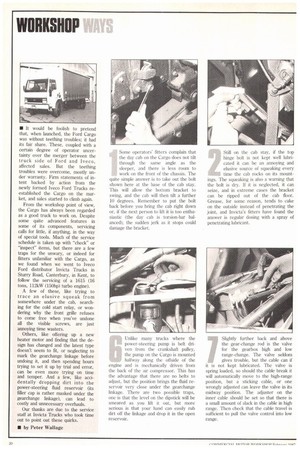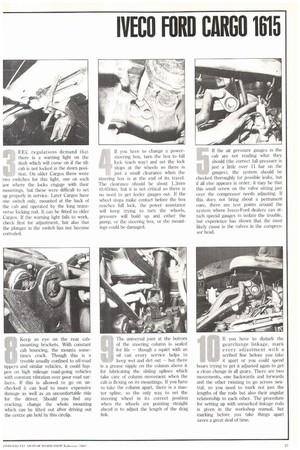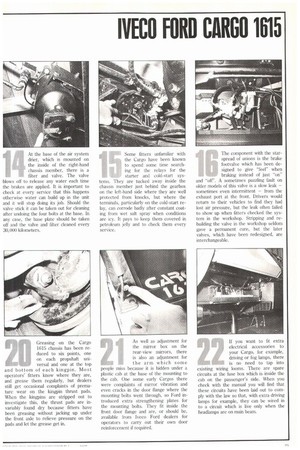Some operators' fitters complain that the day cab on the
Page 66

Page 69

Page 70

Page 71

If you've noticed an error in this article please click here to report it so we can fix it.
Cargo does not tilt through the same angle as the sleeper, and there is less room to work on the front of the chassis. The quite simple answer is to take out the bolt shown here at the base of the cab stay. This will allow the bottom bracket to swing, and the cab will then tilt a further 10 degrees. Remember to put the bolt back before you bring the cab right down or, if the next person to lift it is too enthusiastic (the day cab is torsion-bar balanced), the sudden jerk as it stops could damage the bracket. Still on the cab stay, if the top hinge bolt is not kept well lubricated it can be an annoying and elusive source of squeaking every time the cab rocks on its mountings. The squeaking is also a warning that the bolt is dry. If it is neglected, it can seize, and in extreme cases the bracket can be ripped out of the cab floor. Grease, for some reason, tends to cake on the outside instead of penetrating the joint, and Invicta's fitters have found the answer is regular dosing with a spray of penetrating lubricant. EEC regulations demand that iF there is a warning light on the dash which will come on if the tilt cab is not locked in the down posi tion. On older Cargos there were two switches for this light, one on each jaw where the locks engage with their mountings, but these were difficult to set up properly in service. Later Cargos have one switch only, mounted at the back of the cab and operated by the long transverse locking rod. It can be fitted to older Cargos. lithe warning light fails to work, check first for adjustment, but also that the plunger in the switch has not become corroded. If you have to change a powersteering box, turn the box to full lock (each way) and set the lock stops at the wheels so there is just a small clearance when the steering box is at the end of its travel. The clearance should be about 1.3mm (0.050in), but it is not critical so there is no need to get feeler gauges out. If the wheel stops make contact before the box reaches full lock, the power assistance will keep trying to turn the wheels. pressure will build up and either the pump, or the steering box, or the mountings could be damaged. lithe air pressure gauges in the cab are not reading what they should (the correct full pressure is just a little over 11 bar on the gauges), the system should be checked thoroughly for possible leaks, but if all else appears in order, it may be that this small screw on the valve sitting just over the compressor needs adjusting. If this does not bring about a permanent cure, there are test points around the system where Iveco-Ford dealers can attach special gauges to isolate the trouble, but experience has shown that the most likely cause is the valves in the compressor head.
8 Unlike many trucks where the power-steering pump is belt driven from the crankshaft pulley, the pump on the Cargo is mounted halfway along the offside of the engine and is mechanically driven from the back of the air compressor. This has the advantage that there are no belts to adjust, but the position brings the fluid reservoir very close under the gearchange linkage. There are two possible traps, one is that the level on the dipstick will be smeared as you lift it out, but more serious is that your hand can easily rub dirt off the linkage and drop it in the open reservoir. ISlightly further back and above the gear-change rod is the valve for the gearbox high and low range-change. The valve seldom gives trouble, but the cable can if it is not kept lubricated. The valve is spring loaded, so should the cable break it will automatically move to the high-range position, but a sticking cable, or one wrongly adjusted can leave the valve in its midway position. The adjuster on the inner cable should be set so that there is a small amount of slack in the cable in high range. Then check that the cable travel is sufficient to pull the valve control into low range.
Keep an eye on the rear cabmounting brackets. With constant cab bouncing, the mounts sometimes crack. Though this is a trouble usually confined to off-road tippers and similar vehicles, it could happen on high mileage road-going vehicles with constant vibration over poor road surfaces. If this is allowed to go on unchecked it can lead to more expensive damage as well as an uncomfortable ride for the driver. Should you find any cracking, change the whole mounting which can be lifted out after driving out the centre pin held by this circlip. The universal joint at the bottom of the steering column is sealed for life — though a squirt with an oil can every service helps to P. keep wet and dirt out — but there is a grease nipple on the column above it for lubricating the sliding splines which take care of column movement when the cab is flexing on its mountings. If you have to take the column apart, there is a master spline, so the only way to set the steering wheel in its correct position when the wheels are pointing straight ahead is to adjust the length of the drag link. If you have to disturb the gearchange linkage, mark every adjustment with a scribed line before you take it apart or you could spend hours trying to get it adjusted again to get a clean change in all gears. There are two movements, one backwards and forwards and the other twisting to go across neutral, so you need to mark not just the lengths of the rods but also their angular relationship to each other. The procedure for setting up with unmarked linkage rods is given in the workshop manual, but marking before you take things apart saves a great deal of time. On older Cargos, the hand priming button on the fuel lift pump used to seize, and it was difficult to get rid of air in the system when you changed a fuel filter. The primer has been redesigned to get rid of this problem, and the new type can be fitted to earlier vehicles. You need the hand primer to release air from the top of the fuel filter housing when you change a filter, but apart from this, the Cargo's fuel system is self purging, and there is no need to bleed at pump or injector union nuts. [he cold start system on the 150 engine has both an igniter and an injector in the inlet manifold. The igniter has a ceramic element and seldom gives trouble, though you can check it easily by taking it out and switching on. It should glow red hot. More likely to be the cause of poor cold starting is the air vent on the top of the reservoir for the fuel injector. This is a gauze vent, and it is not shielded so it tends to become blocked or partly blocked with oily dust. If it is only partly blocked, the problem may not show up till really cold mornings. Drivers sometimes complain that the exhaust brake is slow to release and drags when they want to accelerate after using it. The trouble could possibly be a partly blocked exhaust on the air port, but it is more likely to be a simple case of stiff linkage. Invicta fitters have found that this swivel linkage and pin on the exhaust brake flange gets so hot that any lubrication, even high melting point grease, dries out very quickly and the pins tend to seize if the driver has not used the brake for a time. The answer is to check it at every service and keep lubricating it. At the base of the air system drier, which is mounted on the inside of the right-hand chassis member, there is a filter and valve. The valve blows tiff to release any water each time the brakes are applied. It is important to check at every service that this happens otherwise water can build up in the unit and it will stop doing its job. Should the valve stick it can be taken out for cleaning after undoing the four bolts at the base. In any case, the base plate should be taken off and the valve and filter cleaned every 30,000 kilometers. Some fitters unfamiliar with the Cargo have been known to spend some time searching for the relays for the starter and cold-start systems. They are tucked away inside the chassis member just behind the gearbox on the left-hand side where they are well protected from knocks, but where the terminals, particularly on the cold-start relay, can corrode badly after constant coating from wet salt spray when conditions are icy. It pays to keep them covered in petroleum jelly and to check them every service. The component with the starspread of unions is the brake footvalve which has been designed to give "feel" when braking instead of just "on" and "off'. A sometimes puzzling fault on older models of this valve is a slow leak — sometimes even intermittent — from the exhaust port at the front. Drivers would return to their vehicles to find they had lost air pressure, but the leak often failed to show up when fitters checked the system in the workshop. Stripping and rebuilding the valve in the workshop seldom gave a permanent cure, but the later valves, which have been redesigned, are interchangeable.
The heater motor with its double squirrel cage rotors lives under the front grille where it is rather exposed to road dirt and rain. On earlier L ,irgos, the motor used to fail sometimes because damp had got in past the weather sealing. The motor was redesigned with better sealing, but unfortunately it became slightly larger in the process, and you have to file out the housing to get it to fit. It is not all that much trouble, but operators who do not know about it have wasted time taking new heater motors back to parts counters thinking they have been given the wrong model. If you see a Cargo with a cracked slat on the front grille either just above or just below the name badge, you can be almost certain that someone has tried to lift the grille after releasing only the four obvious screws, two at each end. There are, however, two more fixing screws hidden between the slats, one above the name badge and one below it. Even if the slats do not crack, trying to tug the grille up without releasing these screws will break their housing and the grille will rattle. The Cargo's accelerator linkage runs through a crossshaft under the front grille and from there by Bowdentype cable. Any driver complaints of a jerky or sticky throttle can almost always be cured by lubricating and readjusting. Also, a few complaints about the engine being down on power have been traced to the throttle cable not being set up properly. There is an adjuster on the outer casing of the cable where it fixes to its bracket on the front bulkhead. This should be set so that full travel on the pump is reached slightly before full travel on the pedal to allow for slight cable stretch. Greasing on the Cargo 1615 chassis has been reduced to six points, one on each propshaft universal and one at the top arid bottom of each kingpin. Most operators' fitters know where they are, and grease them regularly, but dealers still get occasional complaints of premature wear on the kingpin thrust pads. When the kingpins are stripped out to investigate this, the thrust pads are invariably found dry because fitters have been greasing without jacking up under the front axle to relieve pressure on the pads and let the grease get in. As well as adjustment for the mirror box on the rear-view minors, there is also an adjustment for the arm which some people miss because it is hidden under a plastic cab at the base of the mounting to the cab. One some early Cargos there were complaints of mirror vibration and even cracks in the door flange where the mounting bolts went through, so Ford introduced extra strengthening plates for the mounting bolts. They fit inside the front door flange and are, or should be, available from Iveco Ford dealers for operators to carry out their own door reinforcement if required. If you want to fit extra electrical accessories to your Cargo, for example, driving or fog lamps, there is no need to tap into existing wiring looms. There are spare circuits at the fuse box which is inside the cab on the passenger's side. When you check with the manual you will find that these circuits have been laid out to comply with the law so that, with extra driving lamps for example, they can be wired in to a circuit which is live only when the headlamps are on main beam.




















































































